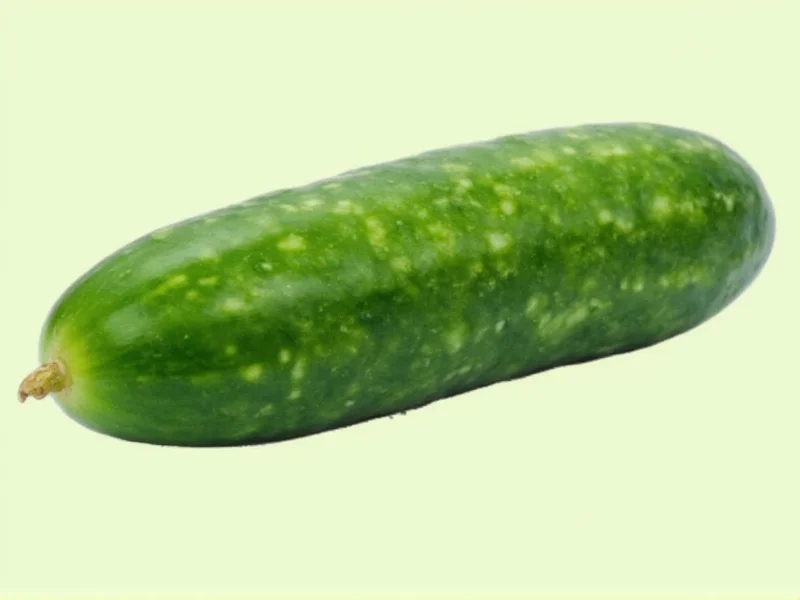Many people wonder about the fundamental distinction between these two common food items. The confusion often stems from seeing them as separate vegetables rather than understanding their direct relationship. Let's explore this culinary transformation in detail to clarify the difference between fresh cucumber and pickle.
What Exactly Is a Cucumber?
Cucumbers (Cucumis sativus) are members of the gourd family, Cucurbitaceae, which also includes melons, squash, and pumpkins. These refreshing vegetables consist of approximately 95% water, making them exceptionally hydrating. Botanically classified as fruits but used as vegetables in culinary contexts, cucumbers grow on creeping vines and come in various types including slicing cucumbers (typically longer and thicker) and pickling cucumbers (shorter, smaller, and often bumpier).
The Pickling Process: How Cucumbers Transform
The difference between a cucumber and a pickle centers entirely on the preservation method. Pickling refers to the process of preserving or extending the shelf life of food by either:
- Vinegar-based pickling: Submerging cucumbers in an acidic solution (usually vinegar) with salt, sugar, and spices
- Fermentation: Submerging cucumbers in a saltwater brine that promotes beneficial bacterial growth, which naturally produces lactic acid
During this transformation process, cucumbers undergo significant changes in texture, flavor, and nutritional profile. The pickling process typically takes anywhere from a few hours (for quick refrigerator pickles) to several weeks (for traditionally fermented pickles).
Key Differences Between Cucumbers and Pickles
| Characteristic | Cucumber | Pickle |
|---|---|---|
| Nature | Fresh vegetable | Preserved food product |
| Texture | Crisp, watery, tender | Firmer, sometimes crunchier (depending on pickling method) |
| Flavor | Mild, slightly sweet, refreshing | Tangy, sour, often with added spices (dill, garlic, etc.) |
| Shelf Life | 1-2 weeks refrigerated | Months to years when properly canned |
| Nutritional Profile | Low in calories, high in water content, contains vitamin K | Higher in sodium, may contain added sugars, retains some vitamins but loses water content |
Common Misconceptions About Cucumbers and Pickles
Several misunderstandings persist about the difference between a cucumber and a pickle. One prevalent myth suggests that pickles come from a different plant species than cucumbers. In reality, all pickles begin as cucumbers—specifically varieties bred for pickling, which tend to be smaller, have thinner skins, and contain fewer seeds.
Another common confusion involves gherkins. While many people use "gherkin" interchangeably with "pickle," gherkins are actually a specific variety of small cucumber (Cucumis anguria) often used for pickling. Not all pickles are made from gherkins, and gherkins can be eaten fresh like other cucumbers.
Nutritional Comparison: Understanding the Health Implications
When examining what is the difference between a cucumber and a pickle from a nutritional standpoint, several key changes occur during the pickling process:
- Sodium content: Pickles contain significantly more sodium than fresh cucumbers due to the salt used in the pickling process
- Probiotics: Fermented pickles (not vinegar-based) contain beneficial bacteria that support gut health
- Vitamin retention: While cucumbers lose some water-soluble vitamins during pickling, they retain certain nutrients like vitamin K
- Calorie content: The calorie difference is minimal unless sugar is added to the pickling solution
For those monitoring sodium intake, understanding the difference between fresh cucumber and pickle nutrition is particularly important. A medium cucumber contains about 2mg of sodium, while even a small dill pickle can contain 300-500mg.
Practical Applications: When to Use Each
Knowing the difference between a cucumber and a pickle helps in culinary decision-making. Fresh cucumbers excel in:
- Salads requiring crisp, watery texture
- Cold soups like gazpacho
- Hydrating snacks and beverages
- Skin care applications due to their cooling properties
Pickles, meanwhile, shine in contexts where:
- Tangy flavor is desired (sandwiches, burgers)
- Extended shelf life is necessary
- Probiotic benefits are sought (with fermented varieties)
- Stronger flavor profile complements other ingredients
Historical Context of Pickling
Pickling represents one of the oldest food preservation methods, dating back approximately 4,000 years to ancient Mesopotamia. The word "pickle" comes from the Dutch "pekel" or northern German "pókel," meaning salt or brine. Ancient Egyptians reportedly served pickles to builders of the pyramids, and Cleopatra believed they enhanced beauty and strength.
Understanding the historical significance helps contextualize the difference between a cucumber and a pickle as more than just a modern culinary distinction—it's part of human food preservation history spanning millennia.
Can You Make Pickles at Home?
Exploring how cucumbers become pickles at home reveals the simplicity of the transformation process. Basic refrigerator pickles require just cucumbers, vinegar, water, salt, and preferred spices. The process typically involves:
- Washing and slicing cucumbers
- Preparing a vinegar-based brine
- Packing cucumbers with spices in jars
- Pouring hot brine over cucumbers
- Allowing to cool and refrigerating for at least 24 hours
For fermented pickles, the process differs slightly, using a saltwater brine instead of vinegar and allowing natural fermentation to occur over several days or weeks.











 浙公网安备
33010002000092号
浙公网安备
33010002000092号 浙B2-20120091-4
浙B2-20120091-4